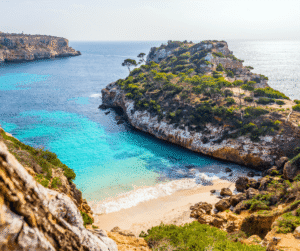Seville is one of Spain’s most enchanting cities, full of culture, sunshine, and centuries of fascinating history. As the capital of Andalusia, Seville has lively neighborhoods, orange tree lined squares, narrow cobbled alleys, incredible food, and the soulful spirit of flamenco.
While iconic sites like the cathedral and Alcázar steal the spotlight, Seville has so much more to offer. From hidden plazas and lush parks to historic palaces and buzzing local barrios, there’s something here for every type of traveller.
Something really important to take into account when visiting Seville is to check the local bank holidays, specially in April with Easter and May with Feria de Abril as you will find massive crowds and some places will be closed for the festivities. Also, Seville may get really hot in summer, the temperatures rise above 40 degrees in August.
To help you plan your perfect trip, here are 20 of the best places to visit in Seville:
1. Seville Cathedral and La Giralda
No trip to Seville is complete without visiting its iconic cathedral. This is the largest Gothic cathedral in the world and a UNESCO World Heritage Site, declared in 1987 alongside the nearby Alcázar and Archivo de Indias.
Construction began in the late 12th century as a mosque, and today, remnants of its Islamic past are still visible (the Patio de los Naranjos and the base of the minaret, which later became the Giralda tower). After the Christian reconquest, the mosque was transformed into the Church of Santa María and, eventually, into the cathedral we see today.
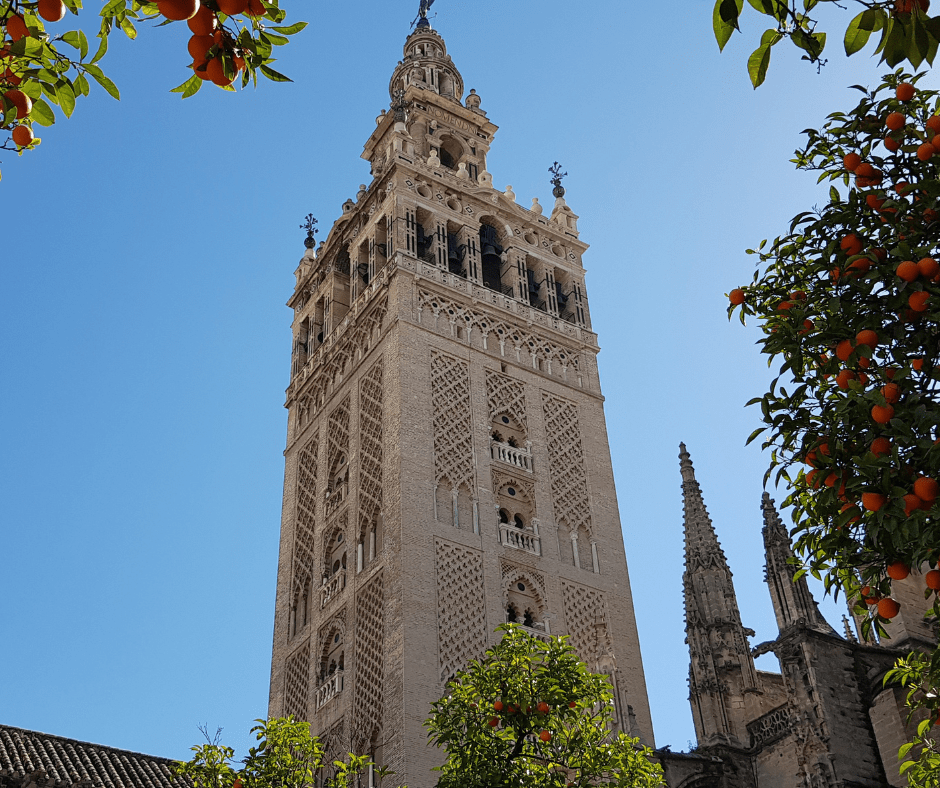
The exterior impresses with its intricate facades and ten monumental doors, especially the Puerta de la Asunción and the Puerta del Perdón. Inside, you’ll find treasures such as the intricately carved choir stalls, richly decorated chapels, the magnificent High Altar, and royal tombs (including the striking tomb of Christopher Columbus) held aloft by four symbolic figures representing the historical kingdoms of Spain.
Once inside, don’t miss the chance to climb the more than 100 meters to the top of the Giralda, the cathedral’s bell tower, which has become one of the city’s most iconic landmarks. From here, you can also get a close up look at the Giraldillo, the sculpture that crowns the tower and symbolizes the Christian victory over the Moors.
Ticket price: From 13€ for adults. From 6€ for over 65.
Official site and tickets: https://www.catedraldesevilla.es/
Free tickets: Sundays (except bank holidays) from 16:30 to 18:00. Booking needed.
2. Seville´s Royal Alcazar
The Royal Alcazar is a palace complex full of intricate tilework, fragrant gardens, and serene courtyards. Still used by the Spanish royal family today, it’s one of the oldest palaces in Europe still in use.
Just a few steps from the cathedral, this walled palace is one of the most beautiful and historically rich in the world.

Originally built in 913. A visit typically takes around two hours, and there are many highlights to enjoy. Don’t miss the Patio de las Doncellas with its reflective pool and elegant arches, the Patio del Yeso, the richly decorated Patio de las Muñecas, the Alcoba Real, the magnificent Salón de Embajadores with its golden dome, and the impressive Salón de Tapices.
After exploring the interiors, take time to wander the palace gardens filled with orange trees, fountains, palms, and peacocks. These gardens offer a perfect blend of tranquility and grandeur, and they were famously featured in the Game of Thrones series.
To fully appreciate the history and avoid long wait times (which can exceed an hour, especially in the heat of summer), it’s worth booking a guided tour. These often include skip the line entry and detailed commentary.
Ticket price: From 15.5€ for adults.
Official site and tickets: https://alcazarsevilla.org/
Free tickets: Mondays. Only selected times. From October to March between 16:00 to 17:00. From April to September between 18:00 to 19:00.
3. Plaza de España
Plaza de España is one of Seville’s most spectacular landmarks. Its semi circular shape, tiled bridges, fountains, and majestic buildings create a perfect scene.
The plaza was completed in 1928 as a tribute to the discovery of the Americas. A canal curves along the base of the building, giving the plaza its nickname “the Venice of Seville.” You can rent a small boat and paddle along the water, passing under four beautiful bridges that symbolize the ancient kingdoms of Spain.
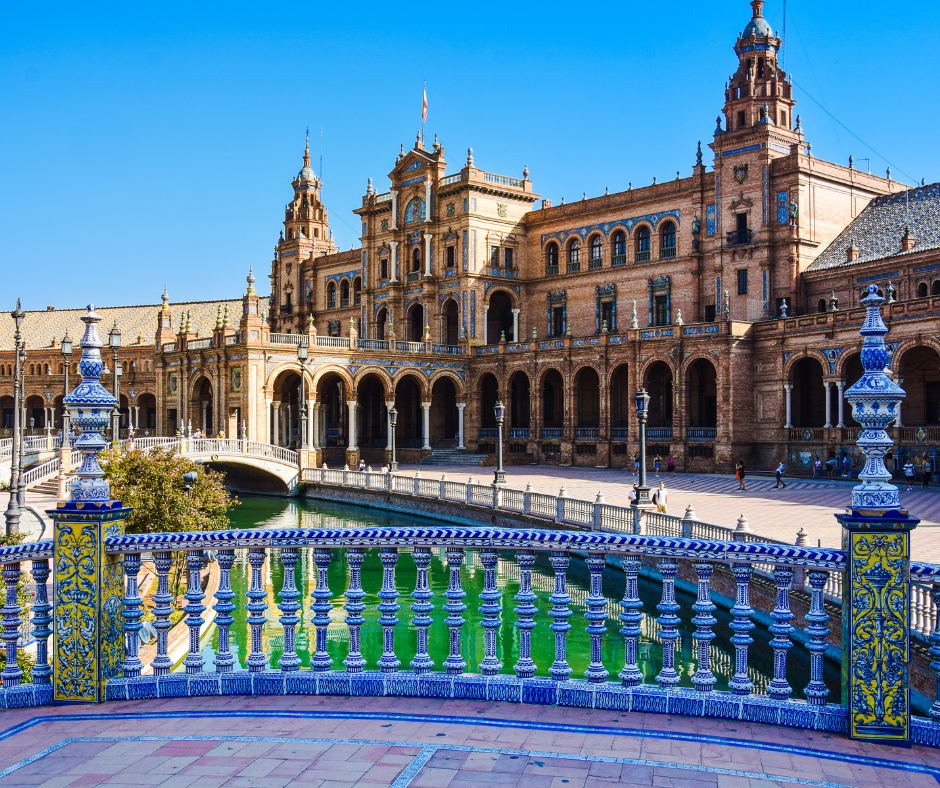
One of the most photographed features of the plaza are the 48 tiled benches, each representing a different province of Spain with detailed maps, coats of arms, and historical scenes.
This grand public space has also served as a film location for major productions, including Lawrence of Arabia and Star Wars: Episode II: Attack of the Clones. Whether you’re admiring the architecture, relaxing by the fountains, or simply enjoying the atmosphere, Plaza de España is a place that leaves a lasting impression.
4. María Luisa Park
After visiting the grandeur of Plaza de España, a relaxing stroll through the Parque de María Luisa is a must. This large park is one of the green lungs of Seville. It’s filled with shady trees, fountains, and romantic pavilions.
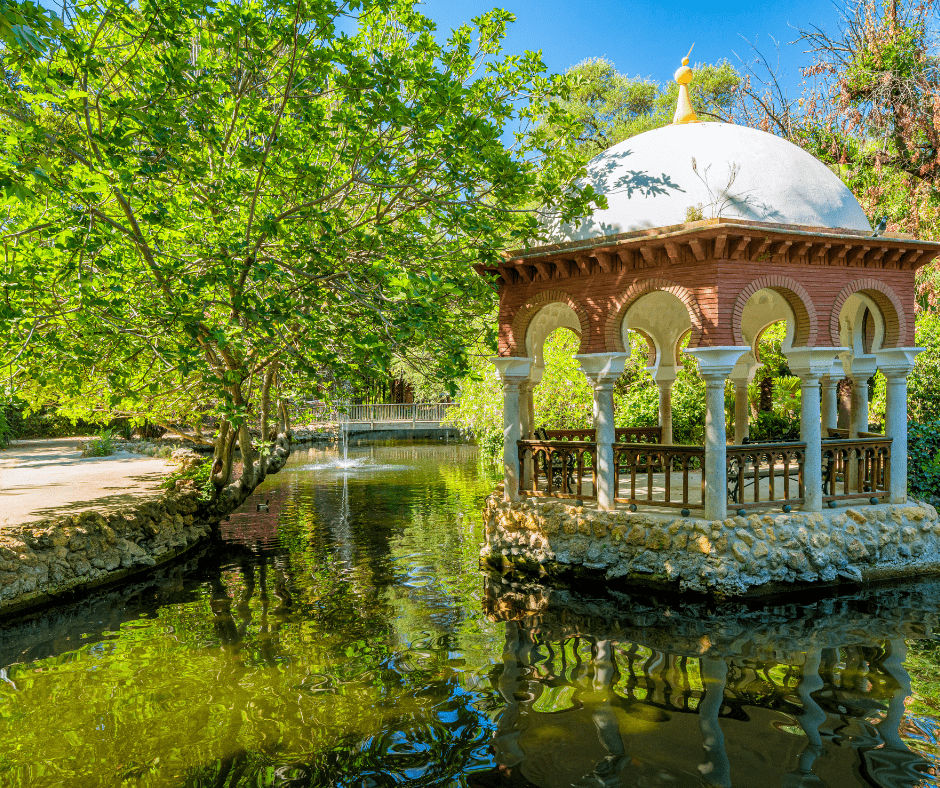
You’ll find a peaceful blend of nature and artistry here, broad avenues lined with towering palm trees, ornate fountains with Arabesque designs, duck filled ponds, and quiet lawns perfect for a walk and to escape the summer heat. One of the highlights is the monument to poet Gustavo Adolfo Bécquer, a favorite spot for locals and romantics alike.
The park is also home to several museums, including the Archaeological Museum and the Museum of Popular Arts and Traditions, both located in stunning pavilions from the Exposition era. Whether you’re looking to rest under the shade, photograph elegant gardens, or explore hidden corners, María Luisa Park is an oasis in the heart of the city.
5. Tower of Gold
This 13th century tower was part of the city’s old defensive walls. Built by the Almohads in 1220, the Torre del Oro stands on the left bank of the Guadalquivir River and is one of Seville’s iconic landmarks.
With a height of 36 meters, it once connected with the nearby Torre de la Plata to help defend the city from naval attacks and pirate raids. Originally serving as a military watchtower, it later took on various roles, including use as a prison for nobles and a gunpowder store.
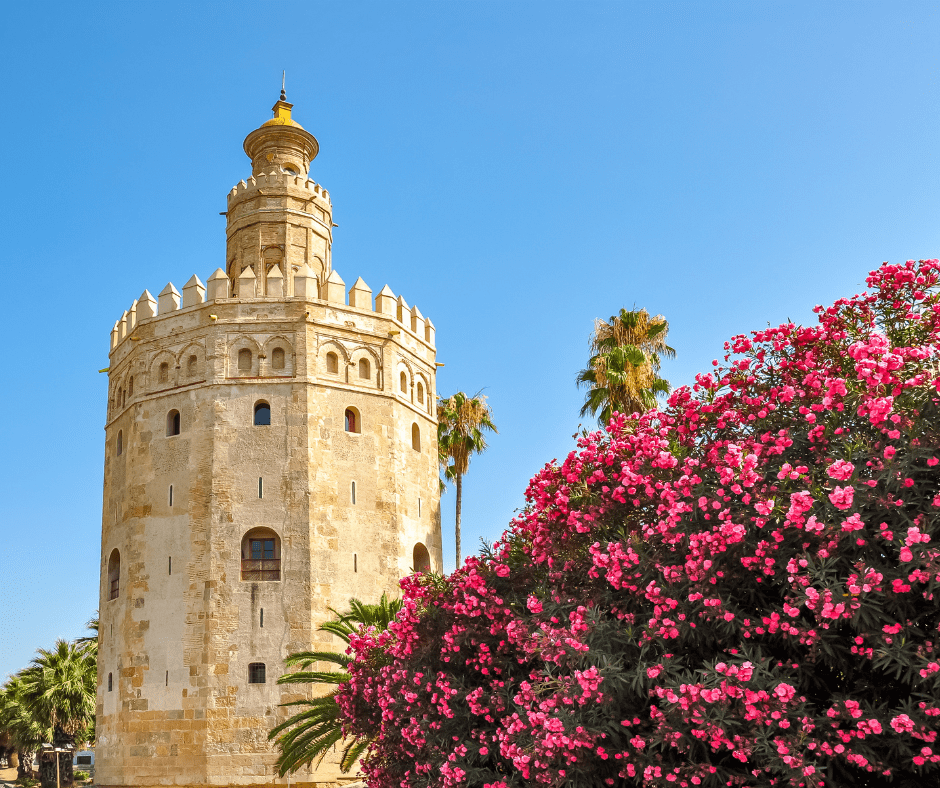
Today, the tower houses the small but fascinating Museo Marítimo, which displays historical maps, navigation instruments, and models of old ships. Visitors can climb to the top for sweeping views of the Guadalquivir River and the city skyline.
One of the most magical ways to admire the tower is during sunset from the San Telmo Bridge or while strolling along the riverbank. In the golden light of dusk or under nighttime illumination, the tower reflects beautifully on the water, giving it a timeless, almost enchanted appearance.
Ticket price: Adults 3€. Over 65 1.5€
6. Metropol Parasol (Las Setas)
Locally known as “Las Setas” (The Mushrooms), this modern wooden structure stands in stark contrast to Seville’s historical architecture. It’s the world’s largest wooden structure and offers panoramic views from its rooftop walkway.
Located in the lively Plaza de la Encarnación, Metropol Parasol surprises many visitors with its size and futuristic design. It has become one of the city’s popular landmarks and a favorite spot for both locals and tourists.
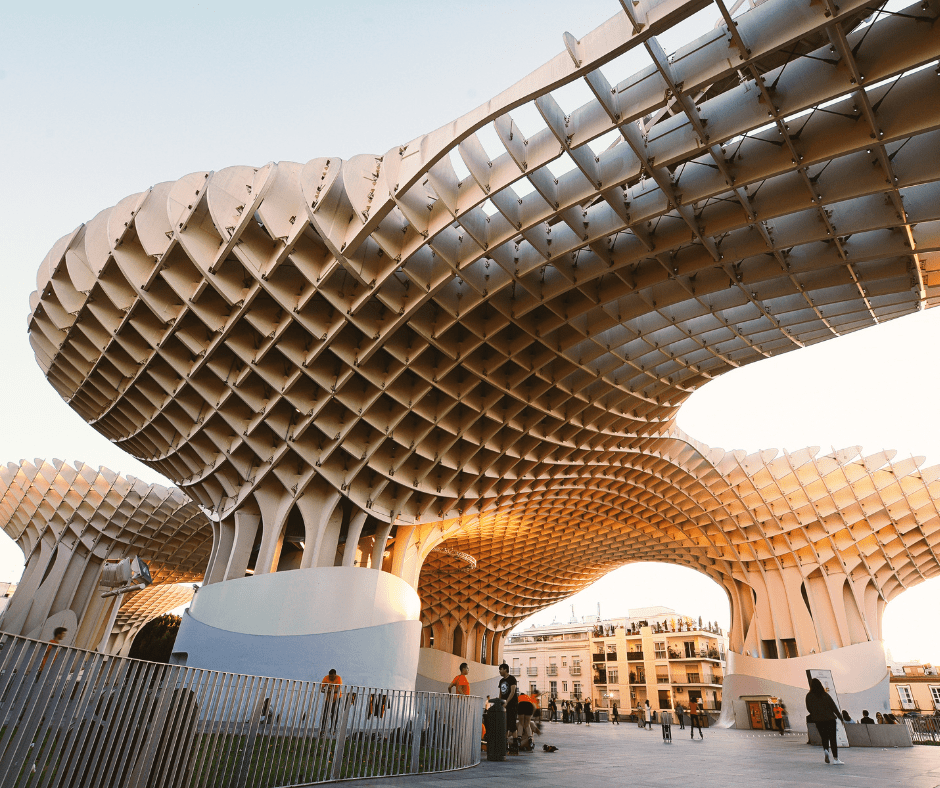
The rooftop offers one of the best viewpoints in Seville, with sweeping views over the old town and beyond. You’ll also get a close look at the structure’s dramatic curves and patterns, which are especially striking at sunset.
Beneath the structure, you’ll find a local market and a spacious public square where you can relax, grab a snack, or enjoy various events. Don’t miss the Antiquarium on the lower level, a fascinating archaeological museum showcasing Roman mosaics and remains of ancient Islamic buildings uncovered during the site’s construction.
Whether you’re visiting for the architecture, the views, or the history beneath your feet, Las Setas is a modern highlight not to be missed in Seville.
Ticket price: Adults from 16€
7. La Cartuja
Located on an island in the river, this former Carthusian monastery is now home to the Andalusian Center for Contemporary Art. The mix of old religious buildings with modern art spaces is unique and worth exploring.
One of the highlights is the wooden footbridge that leads to the Jardín Americano, a unique botanical garden featuring more than 300 plant species native to the Americas.
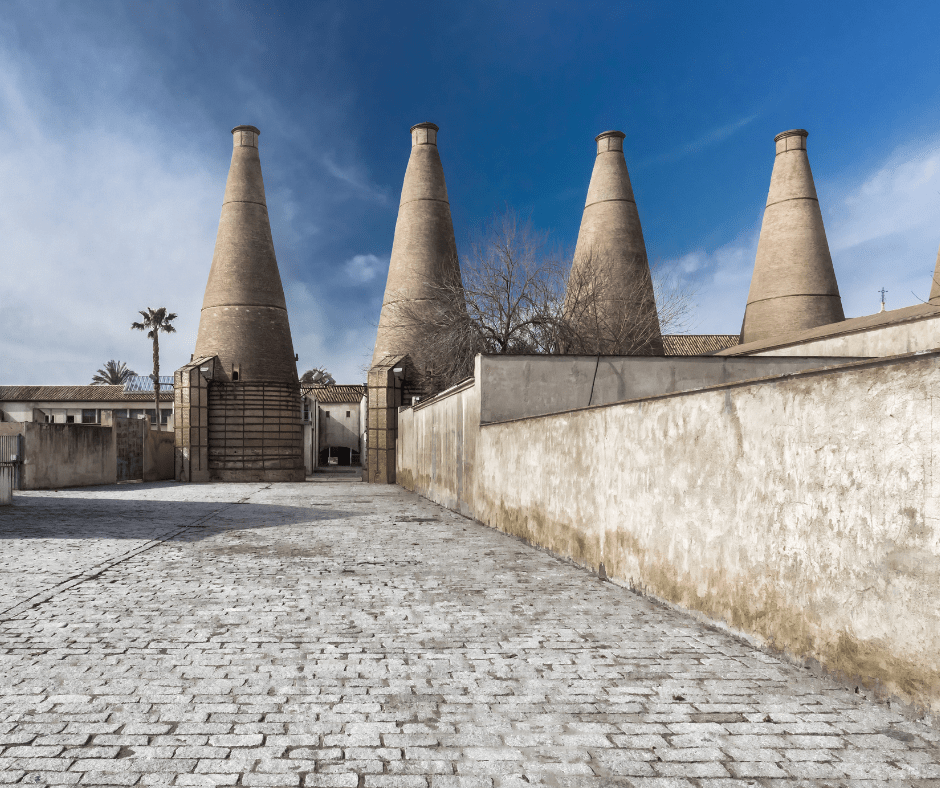
At the heart of the island is the Monasterio de Santa María de las Cuevas, a 15th century monastery. Over the centuries, it served as a monastery, a ceramics factory, and now houses the Centro Andaluz de Arte Contemporáneo (CAAC).
For families visiting Seville, La Cartuja also offers Isla Mágica, a theme park with rides and shows. Right next to it is Agua Mágica, a seasonal water park, perfect for cooling off during Seville’s hot summer months.
La Cartuja offers something for everyone: history, art, nature, and fun… all just a short walk or bike ride from the historic center.
Ticket price: 1.8€ for the monument. 1.8% for the gallery. 3€ combine tickets.
Official site and tickets: https://www.caac.es/en/
8. Santa Cruz Quarter
This is Seville’s most charming neighborhood. This picturesque quarter is the historic heart of the city, where every turn reveals hidden patios, centuries old churches, and inviting tapas bars where the spirit of Seville truly comes alive.
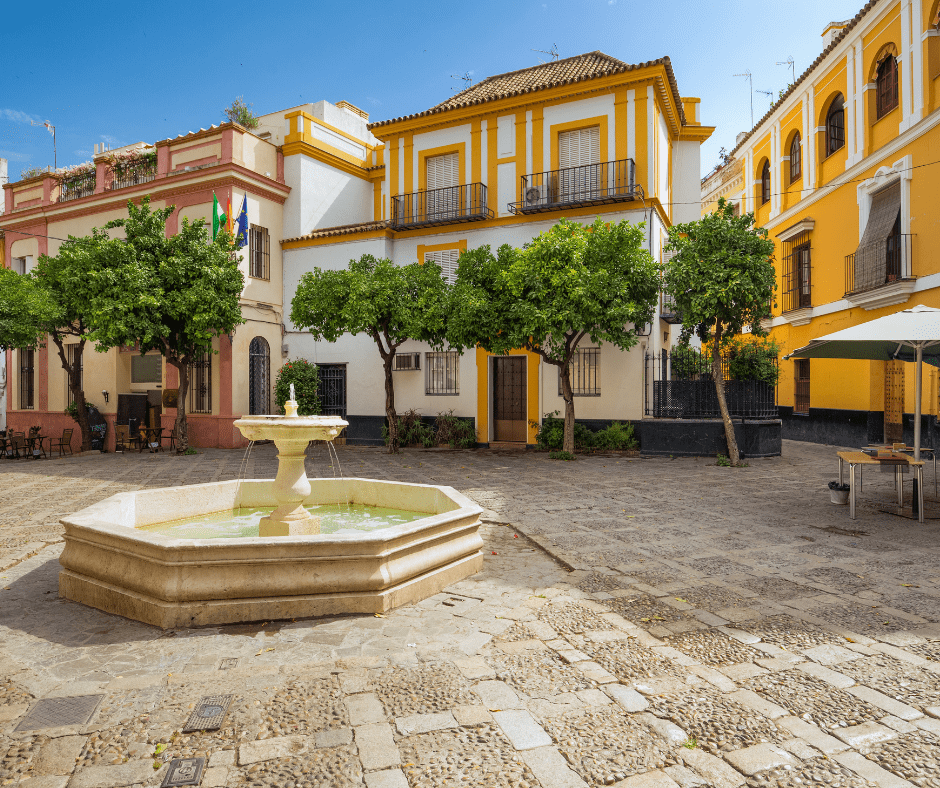
The area is rich with highlights: the peaceful Plaza de Santa Cruz, home to the renowned flamenco venue Los Gallos; the romantic Callejón del Agua; narrow Calle Pimienta; the atmospheric Plaza de Doña Elvira; and the Hospital de los Venerables.
When you’re ready for a break, stop for some delicious tapas at iconic spots like Bodega Las Columnas, Taberna Álvaro Peregil, or Bar Las Teresas, favorites among both locals and visitors for their authentic Sevillian flavors.
9. Macarena Basilica
A little outside the city center, the Basilica de la Macarena is home to one of the most cherished figures in Seville “Our Lady of Hope, or La Macarena”. Dearly beloved by locals, she plays a central role in the city’s Semana Santa (Holy Week), where her procession is among the most moving and attended events.
Next to the basilica is the Arco de la Macarena, one of only three remaining access points from Seville’s ancient city walls. This arch frames a gateway into a more traditional, less touristy side of the city.
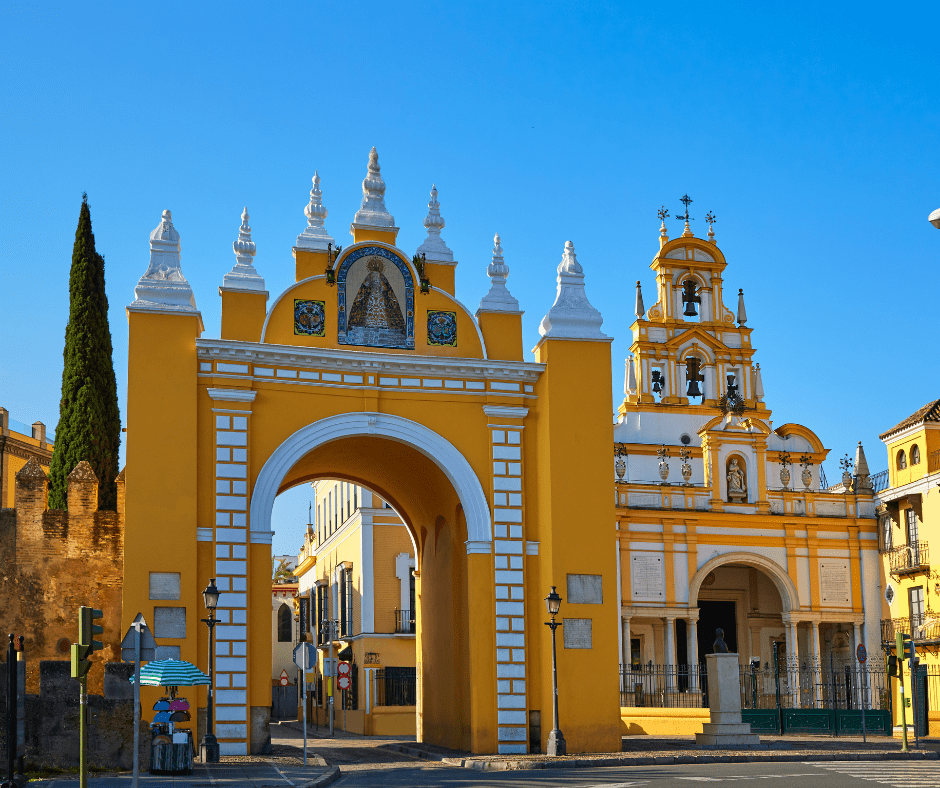
We recommend the 20 minute walk from the cathedral, which allows you to explore other neighborhoods and pass by the Church of San Luis de los Franceses, a spectacular 18th century Baroque gem.
On the way back to the center, consider stopping at Plaza de San Lorenzo to visit the Basilica of Jesús del Gran Poder, another major figure of Seville’s Holy Week. And to top it all off, treat yourself to some of the city’s best “croquetas” at Casa Ricardo, a beloved local eatery right around the corner.
Ticket price: 3€ for adults.
10. Casa Pilatos
Casa de Pilatos is one of the most beautiful and historic mansions in Seville. The palace has its roots in the 15th century and came about from the union of two powerful noble families: the Enríquez and the Ribera. Their admiration for Italian art and culture helped shape the palace’s distinctive Renaissance style.
Inside, visitors can marvel at exquisite wooden ceilings, Mudéjar style tiles, and one of Spain’s finest collections of classical sculpture, amassed by the 1st Duke of Alcalá during his travels in Italy.
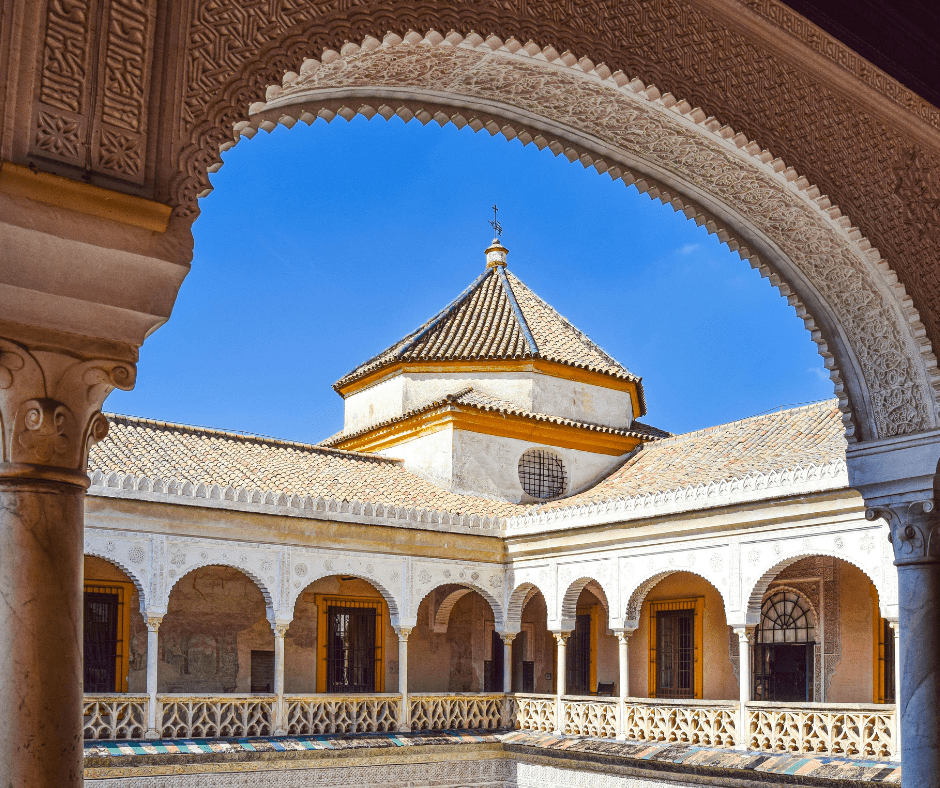
The palace has also captured the imagination of filmmakers. It has served as a set for four major Hollywood productions: Lawrence of Arabia, Knight and Day, 1492: Conquest of Paradise, and Kingdom of Heaven, directed by Ridley Scott.
Whether you’re drawn by its rich history, stunning architecture, or cinematic connections, this palace is an unforgettable stop in Seville.
Ticket price: Ground floor 12€. 6€ more to access the top floor with guide tour.
Official site and tickets: https://fundacionmedinaceli.org/monumentos/casa-de-pilatos/
11. Museum of Fine Arts of Seville
Considered the second most important art gallery in Spain after the Prado Museum, the Museo de Bellas Artes is a must visit in Seville. It’s housed in the magnificent former Convent of La Merced Calzada, a striking 17th century building with peaceful cloisters and ornate courtyards.
Inside, you’ll find an impressive collection of Spanish art from the medieval period to the early 20th century. The museum is especially renowned for its large body of works by Bartolomé Esteban Murillo, one of Seville’s most celebrated painters. Other masters featured include Zurbarán, Valdés Leal, El Greco, and Goya.
Each room is arranged chronologically or thematically, providing visitors with a rich journey through the evolution of Spanish painting. Whether you’re an art enthusiast or just curious to explore, the museum offers an insightful look at Seville’s artistic legacy.
Ticket price: 1.5€ for adults.
12. Archivo de Indias
Located next to the cathedral, this UNESCO World Heritage Site is housed in a grand Renaissance building commissioned by King Philip II in 1584. The Archivo de Indias was created to centralize and preserve all the documents related to Spain’s Americas overseas empire.
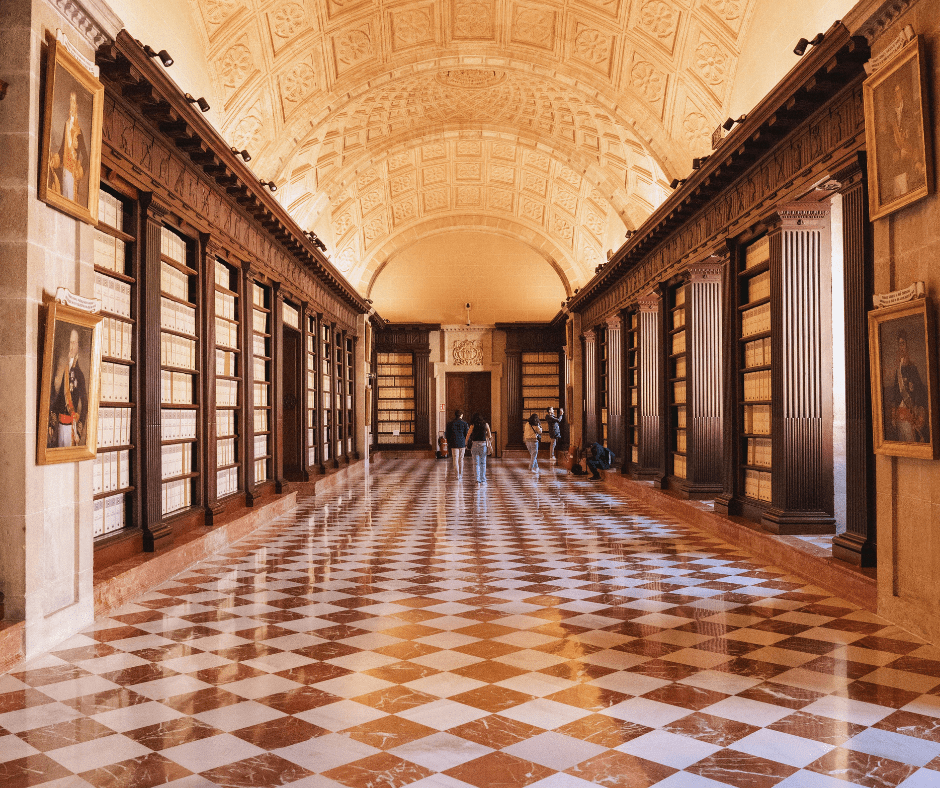
It contains an extraordinary collection of historical materials, more than 43,000 files, 80 million pages, and 8,000 maps and drawings. These archives include writings and correspondence from key figures in the Age of Exploration such as Christopher Columbus, Ferdinand Magellan, Hernán Cortés, and Francisco Pizarro.
Visitors can explore exhibits of ancient maps, treaties, and royal decrees that provide a fascinating glimpse into the administration and conquest of the New World. The entrance is free, and even a short visit reveals how this institution shaped our understanding of a pivotal era in global history.
Ticket price: Free.
13. Barrio Triana
Triana is a vibrant, colorful barrio full of life, music, and tradition. It’s an ideal place to lose yourself wandering streets like Calle Betis, Calle Pureza, and Calle Rocío, where you’ll see colorful façades, historic churches like Santa Ana and the Chapel of the Sailors.
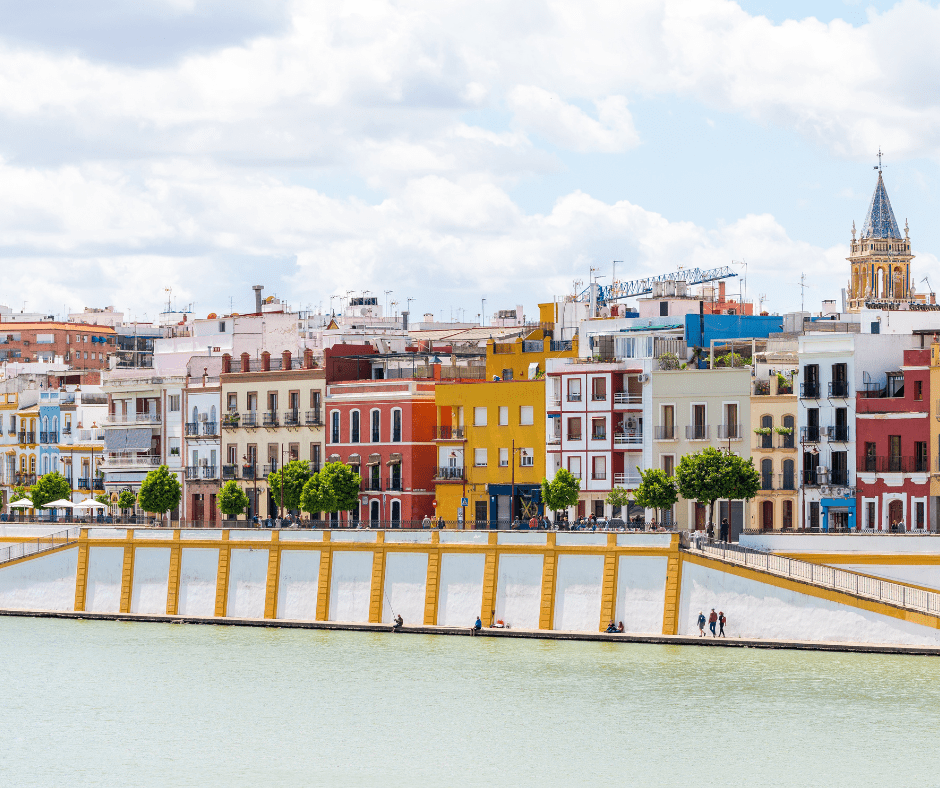
Be sure to visit the Mercado de Triana, located next to the historic Castle of San Jorge and the Callejón de la Inquisición, where you can sample Andalusian flavors and browse fresh local foods. The neighborhood also preserves a strong tradition of craftsmanship where you can still visit workshops to learn more about the area’s iconic pottery heritage.
If you’re interested in flamenco, Triana is the place to be. Book a show at Tablao Baraka or the Flamenco Dance Museum, two of the top venues to experience this passionate art form.
14. San Francisco Square
The square is flanked by beautiful, colorful façades and historical buildings (Casa Consistorial, the city’s Town Hall), creating a picturesque setting perfect for strolling or relaxing at one of its outdoor cafés. Despite its current charm, Plaza San Francisco has a complex past, it was once used for public spectacles such as “autos de fe” during the Inquisition. Today, it holds a place of honor during Seville’s Holy Week, as one of the prime spots for viewing processions from its exclusive viewing boxes.
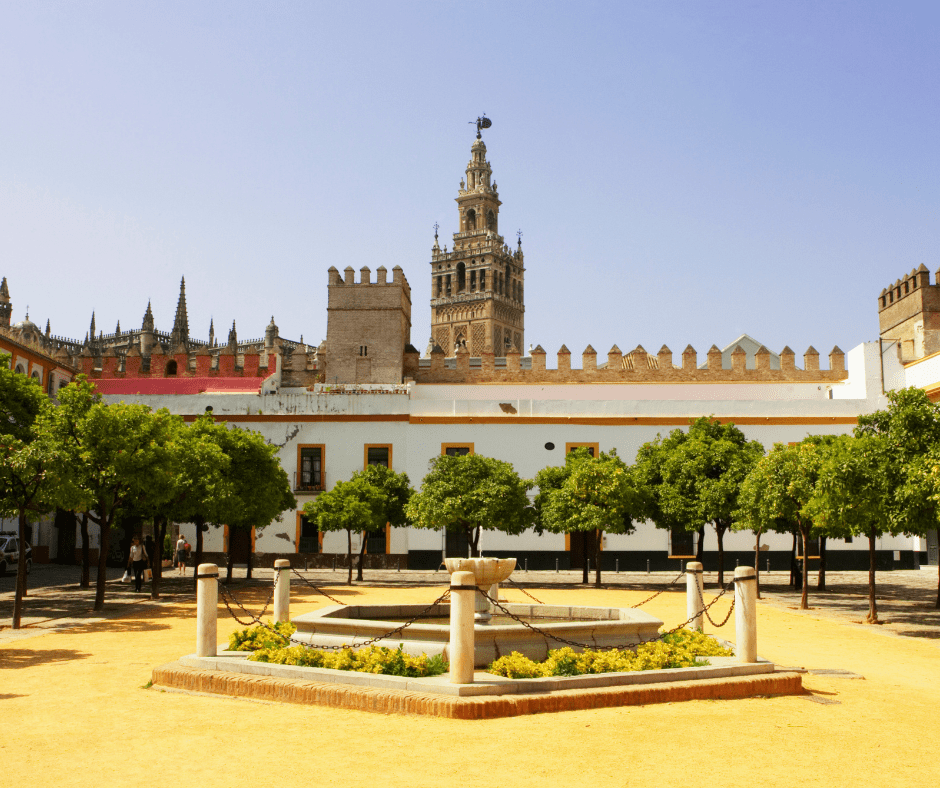
15. Cabildo Square
Tucked away behind the cathedral, Plaza del Cabildo is one of the most peaceful and charming spots in Seville’s historic center. This semi circular interior plaza is like a hidden oasis, accessed through one of three archways that open up to reveal a space full of quiet charm.
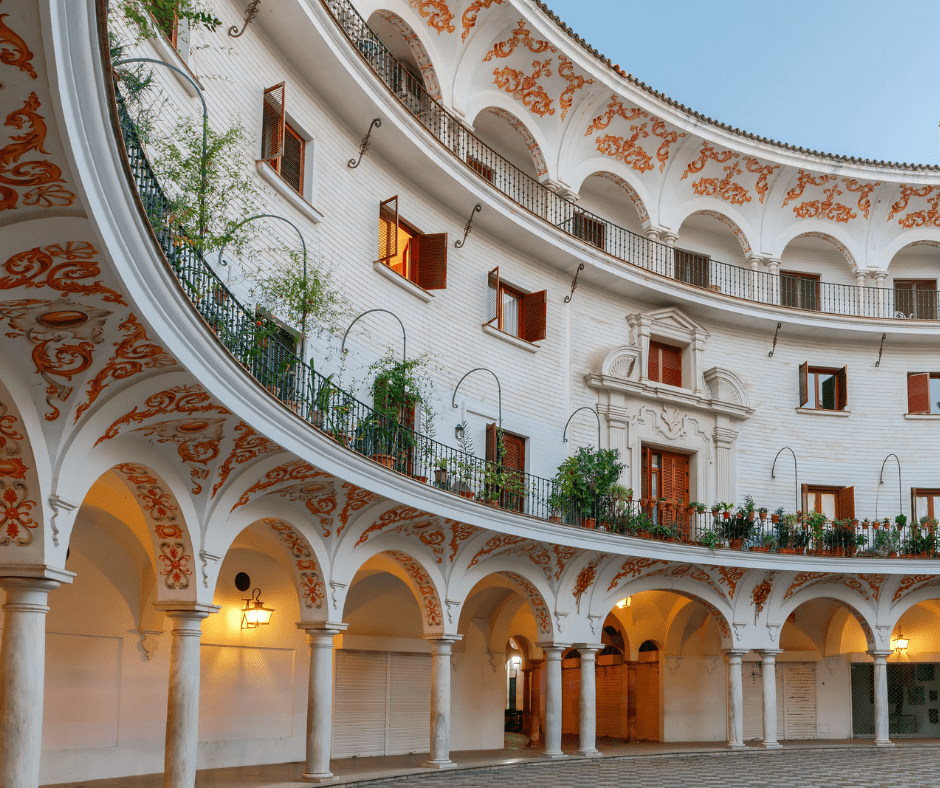
At the center of the plaza stands a lovely fountain, surrounded by elegant buildings with wide balconies and a graceful arcade supported by marble columns. On the ground floor, you’ll find small shops specializing in antiques, coin and stamp collecting, and religious artifacts. Every Sunday, the square comes to life with a local market a must for treasure hunters and curious visitors alike.
Its central location, architectural elegance, and unique offerings make Plaza del Cabildo a delightful hidden gem to explore during your visit to Seville.
16. La Maestranza
Seville’s bullring is one of the most famous in Spain and a key part of the city’s cultural and historical identity. Each year, during the Feria de Abril, La Maestranza hosts one of the most prestigious bullfighting festivals in the country. The atmosphere, tradition, and skill on display attract aficionados from across the globe.
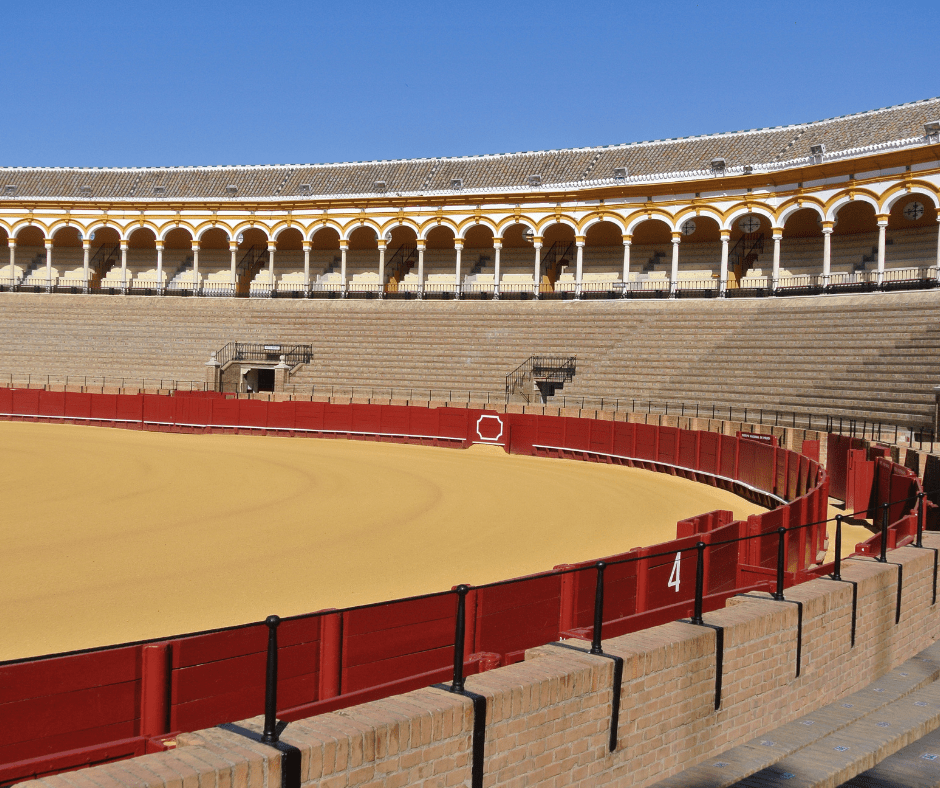
The bullring also houses the Museo Taurino, a museum that offers an in depth look at the history and significance of bullfighting in Andalusia. Here, you’ll find costumes, artwork, and historical artifacts that shed light on this controversial yet deeply rooted tradition.
Even for those who don’t attend a bullfight, a guided tour of the arena and museum provides a fascinating insight into a cultural practice that has shaped much of Seville’s identity. The architecture alone makes the visit worthwhile.
Ticket price: From 6€ for adults.
17. Hospital of Venerable Priest
Located in the Barrio de Santa Cruz, the former Hospital de los Venerables Sacerdotes was founded more than three centuries ago to care for elderly and sick priests. The building has since been transformed into a cultural center and now houses the renowned Velázquez Center.
The center is dedicated to researching and promoting the works of Diego Velázquez and other masters of the Spanish Baroque period, including Murillo, Martínez Montañés, and Pedro Roldán.
The church inside the complex is a gem. Built in the late 17th century, it features contributions from renowned artists like Murillo and Valdés Leal, and the frescos on the ceilings and dome (illusionistic paintings by Valdes) are especially impressive.
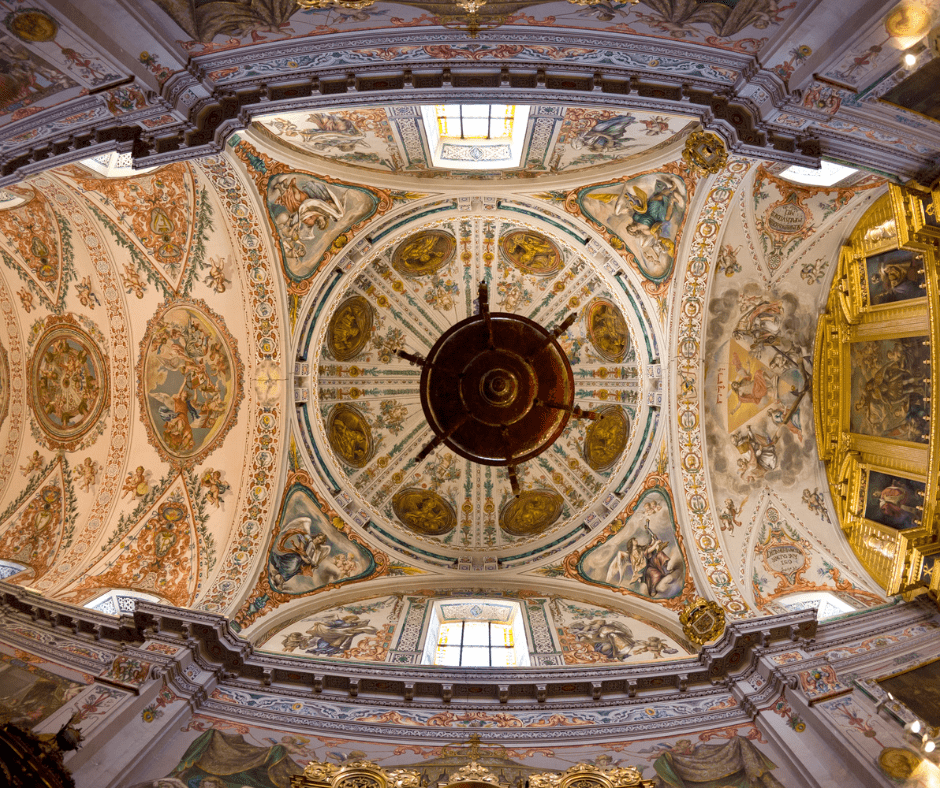
In addition to its permanent exhibits, the upstairs gallery regularly hosts temporary exhibitions that explore Spanish art and history. It’s a peaceful and inspiring place to pause and appreciate Seville’s rich cultural heritage.
Ticket price: 12€ for adults.
Official site and tickets: https://losvenerables.es/cultural-visit/
18. Hotel Alfonso XIII
Built in 1929 to host visiting royalty during the Ibero American Expo, this five star hotel is one of Seville’s most luxurious and iconic buildings. Designed in a blend of Mudéjar, Gothic, and Renaissance styles, Hotel Alfonso XIII feels more like a palace than a hotel.
Even if you’re not a guest, it’s well worth stopping by. You can enjoy a glass of wine or a coffee at Ena Sevilla, the hotel’s elegant outdoor terrace, which welcomes non guests and provides the perfect setting for relaxing atmosphere. Once inside, take a moment to admire the grand staircase, intricate tilework, and even the beautifully ornate restrooms.
The hotel’s restaurant and bar are also open to visitors, offering fine Andalusian cuisine in a refined setting. Whether you’re exploring its opulent lobby or taking in the views from the lush courtyard, a visit to Hotel Alfonso XIII offers a glimpse into Seville’s aristocratic past with all the comforts of modern luxury.
19. Palacio de las Dueñas
Owned by the influential and aristocratic Casa de Alba, the palace showcases a blend of Gothic Mudéjar and Renaissance styles that captivate visitors from the moment they enter.
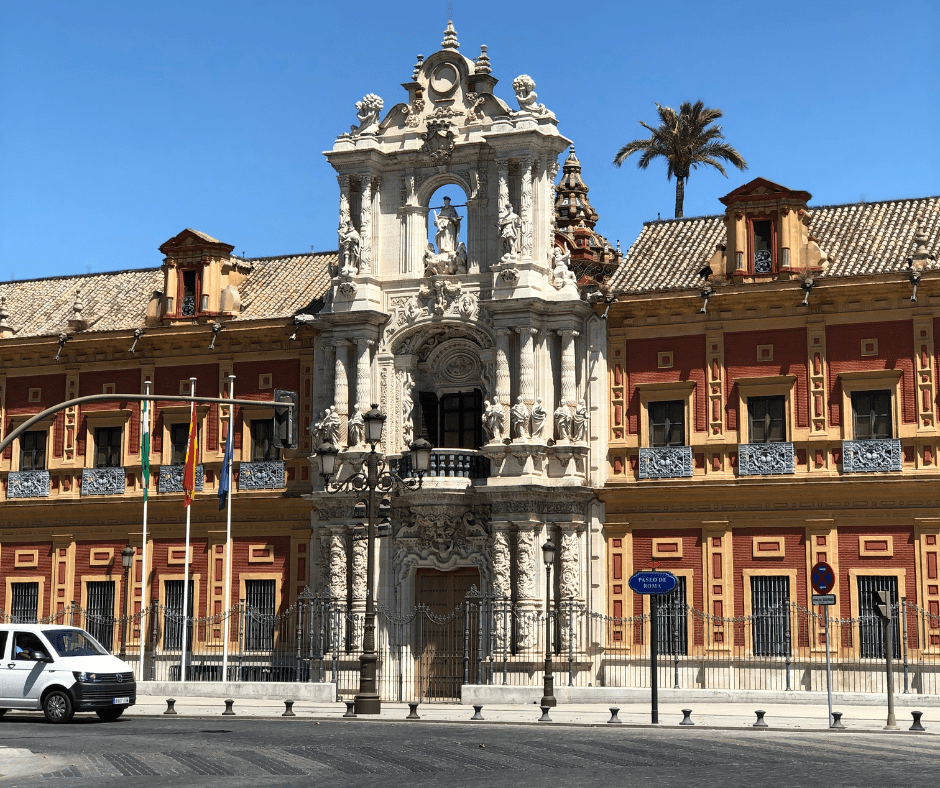
One of the palace’s most enchanting features is its network of patios and gardens, overflowing with life. These lush spaces are home to thousands of plants, including fragrant orange trees, lemon trees, and vibrant seasonal flowers that create a tranquil, almost poetic atmosphere.
Ticket price: 14€ with audio guide visit.
Official site and tickets: https://palacioduenas.janto.es/
Free: Mondays afternoon.
20. Church of Divine Savior
The Divino Salvador Church is one of the most stunning examples of Andalusian Baroque architecture. It’s the second largest religious building in the city after the cathedral.
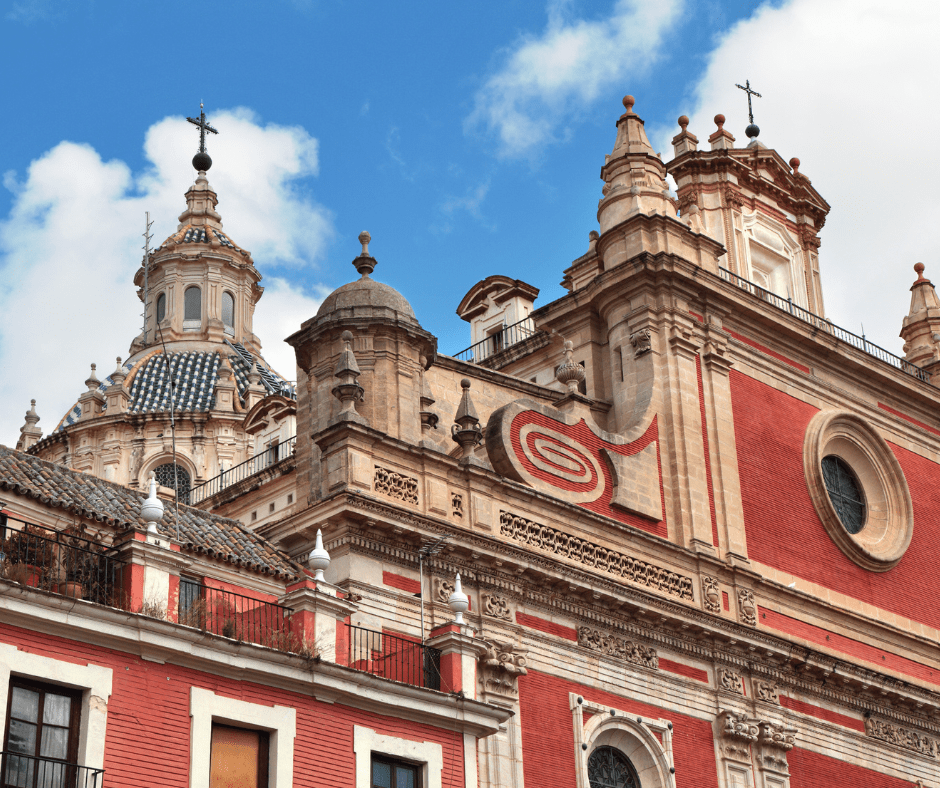
Its grand interior is known for its impressive altarpieces, including the elaborately carved High Altar and the stunning sacramental chapel. The church also houses an 18th century baroque organ and several side chapels decorated with sculptures and paintings by notable Spanish artists.
The space retains a powerful spiritual atmosphere and is often less crowded than the cathedral, making it a more peaceful place to reflect and admire the artistry. Its entrance is included with the Seville Cathedral ticket, so it’s easy to combine both visits. Don’t miss the chance to explore its richly adorned naves and elegant dome, which make it a jewel of Seville’s religious heritage.
Ticket price: 6€ for adults.
Other tickets: It can be added as multiple ticket entry for Cathedral + Giralda + Church for 13€
Whether it’s your first time in Seville or your fifth, this city has a magical way of surprising you. With every plaza, palace, and patio, you’ll uncover a new piece of its soul. So take your time, enjoy the moment, and let Seville work its charm on you.
Bonus Tips for Visiting Seville
- Best time to visit: Spring (especially April) and autumn offer the most pleasant weather. April is also when the Feria de Abril takes place, a lively local fair full of music, food, and dancing.
- Dress for walking: Seville’s charm is best discovered on foot, so comfortable shoes are a must.
- Stay hydrated: Summers can be extremely hot, so always carry water and try to plan indoor or shaded activities during the midday heat.
- Local flavors: Try classic dishes like salmorejo, espinacas con garbanzos (spinach with chickpeas), and churros with chocolate. Pair them with a glass of local sherry or tinto de verano.
- Flamenco: Book tickets in advance if you want to experience a show at a reputable venue as many fill up quickly, especially in the Santa Cruz or Triana neighborhoods.
- Public transport: The city is very walkable, but there are also bikes, trams, and buses to help you get around. A rechargeable transport card can save money if you plan to use public transport frequently.
- Siesta culture: Many shops and smaller businesses close between 2pm and 5pm. Use this time to relax or enjoy a leisurely lunch like the locals do.
Sevilla offers an unforgettable experience at every turn. From the timeless elegance of the Alcázar and the inspiring cathedral to hidden plazas and lively tapas bars, each stop on this list reveals a different facet of Seville’s soul. Take your time, let yourself get a little lost, and soak in the beauty, history, and warmth that make Sevilla one of Spain’s most magical destinations.




